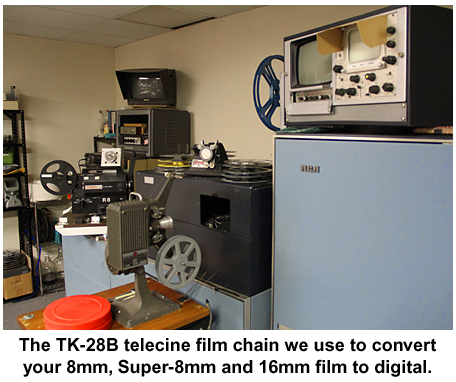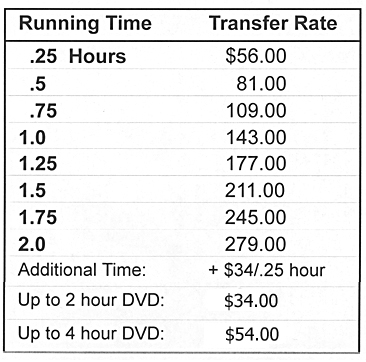|
|
16mm Movie Film
Invented
by Eastman Kodak way back in the early 1920's, 16mm was the first film
format to be used for making home movies by the masses. The cameras were
smaller and simpler to operate and, although quite expensive for their
day, 16mm did allow people with the money to do so, to shoot real motion
pictures of their family and friends. Something that was not truly
possible up until that point. While there was 35mm film for use in movie
theaters this film was Nitrate-based and not safe for home use. It was
also only available as a camera negative so not suitable for direct
projection unless a positive print was made from it. When Kodak came out
with 16mm film... first only as black and white camera stock, it was in
a form called reversal safety film. Not only was it
the film you loaded into the camera it was also the same film, after
processing, you could use in your projector. Because it used a
completely new film base made from acetate there was no possibility of
it catching fire, unlike 35mm Nitrate which was combustible if not
handled carefully. It was at this point the home movie industry was born
in the US. An interesting article about one of the most popular 16mm
home movie cameras of all time can be found at this web site.

The process to convert 16mm film to a digital format:
Our process to transfer 16mm silent film, black and white and
color, uses the same film chain or "telecine system" we use for 8mm and
S8mm, the RCA TK-28B seen in this picture to the right.
The TK-28B is a three-tube vidicon film chain. It separates the film's
picture into its red, green and blue elements before processing. The
TK-28B is equipped with a 5 "F" stop inconel neutral density light wheel
to compensate for density and exposure in real time. Exposure
correction is accomplished automatically every 1/30th of a second by
measuring the peak white level in the output of the video signal.
Automatic black level is also used to provide for proper gamma range.
Color correction is applied to maintain accurate whites in the clearest
parts of the film frame. Detail correction is adjusted and injected into
the luminance channel based on the overall sharpness level of the
original film. The TK-28B delivers the most realistic and most lifelike
image from your home movies. It truly is, as one of our local customers
put it "like looking through a window when I'm watching it on my TV
screen". Below, is a chart that shows the rates for converting 16mm
silent movie film to DVD.
We also have an info packet
you can download as a PDF file. All the pricing and order information
is then available in printed form for you to go over at your leisure.
The forms you will need to send in your film are also there.
Computing the charges to convert 16mm film to a digital format:
 Computing your costs is a simple process. Your original 16mm film will
more than likely be on any of three reel sizes. The most common is the
4" 100 foot reel, followed by the 3" 50 foot reel. If your family was
in to editing their movies they may have wound them up onto 7" 400 foot
reels for a more uninterrupted viewing experience. You simply need to
add up the footage to come up with an overall total between the various
reel sizes then divide that figure by 1350 feet. The amount of film that
can be converted in one hour of transfer time. That will be your
running time, added up to the next quarter of an hour. Look on the chart
and you will see the cost to transfer that amount of film. Computing your costs is a simple process. Your original 16mm film will
more than likely be on any of three reel sizes. The most common is the
4" 100 foot reel, followed by the 3" 50 foot reel. If your family was
in to editing their movies they may have wound them up onto 7" 400 foot
reels for a more uninterrupted viewing experience. You simply need to
add up the footage to come up with an overall total between the various
reel sizes then divide that figure by 1350 feet. The amount of film that
can be converted in one hour of transfer time. That will be your
running time, added up to the next quarter of an hour. Look on the chart
and you will see the cost to transfer that amount of film.
The transfer process:
Our normal procedure is to transfer to raw mpeg2 direct from the telecine system into one of our servers. From there the various reel segments are edited and combined into a final, fully authored DVD. This DVD becomes your master. It is advisable to order at least one duplicate set made from the master(s) and keep the master set with your films. In addition to the DVD set you will also be supplied with a thumb drive of the fully edited digital file along with access to a digital download of the completed transfer for you to install on your smart phone or tablet. This gives you complete convenience no matter where or how you elect to view your film transfers.
Remember, these rates are inclusive of all services and supplies to get your film in shape for the transfer. We do not charge you extra for inspection, film reels, leader, splices or cleaning solution. The charge you see is the charge you can expect to pay based, of course, on the total amount of film you actually have, in 1/4 hour increments. This factor, alone, sets
us apart from most other film transfer services out there. Many will impose additional charges for the 400' plastic reels used to assemble your smaller reels before the transfer as well as charge for splicing and cleaning your film. The special anti-static and anti-fungal film cleaner we use costs us over $100 per gallon!
Apple ProRes Film Transfers (for professionals and advanced amateurs):
For customers who require the highest possible image quality, because they may be doing additional editing and/or post-production, we can supply your transfers using the Apple Quicktime ProRes codec. Apple ProRes 422 is a high quality, lossy video compression format developed by Apple.
It requires that you have Apple Final Cut Pro or iMovie for the Mac. There is also a low-cost program called Mojave that will edit ProRes on the PC. You will need to supply a fully formatted, wiped USB hard drive to us with your film. The drive will be formatted using exFAT, which is compatible with both the PC and most recent Mac machines,
unless you have already done so. There is a charge of $20 to cover the cost of the backup and housekeeping for this service.
This web site is Copyright © 2006 - 2020 TFG Film & Tape, All Rights Reserved.
This site or any of its contents may not be copied or mirrored on any other web site or
used in any document, printed or electronic, without the express permission of this site's owner.
If you find certain wording or phraseology used above to explain our work or services on other
web sites please know it has been pilfered from us and is a clear violation of our copyright.

We can transfer your priceless 16mm movie films to a digital file or DVD and preserve these memories on a format you can enjoy today in Waterbury, Windsor, Essex, New London, Farmington, Simsbury Connecticut, film transfers from 16mm film are best done on a telecine system that can correct for exposure, density and color on a frame by frame basis, digitize your 16mm movie film and have it converted to DVD for viewing any time you choose, we have the process to convert 16mm film to DVD or digital and do it the correct way, 16mm film transfers or 16mm film conversions, digitizing 16mm film at TFG Transfer in Wethersfield Connecticut
|
|
|

